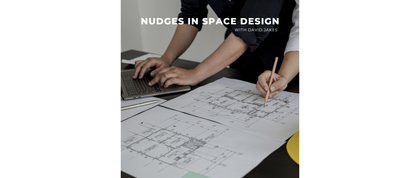Loading...

Nudges in Space Design
David Jakes
Learning from home, however home was defined, was a challenging experience during the pandemic for many students. The opportunity to reassemble in schools has presented the opportunity to re-engage in the timeless experience of school. In this space, kids that want to learn meet the adults that are committed to helping them do that. As you know, the physical spaces of the school are the canvas for this interaction.
Today, now more than ever, it is critical to consider the Reggio Emila concept that the spaces of school serve as a third teacher. The philosophy suggests that there are three teachers, adults (parents and teachers), peers, and space. When applying this construct to school spaces, this philosophy elevates the role that space has in the education of children.
As an educational designer, my role is to design spaces that have an active role in the education of students. To extend that role and the way in which I design, I’m interested in how spaces can become and act as agents in the learning process.
For example, how would spaces be designed to prevent the escalation of a particular undesirable behavior? How could spaces act on behalf of learners and cue learners to engage in positive behaviors that enable the right behaviors, including making the right choices that lead to a condition of well-being?
To accomplish this, it is necessary to create environments that are intentionally designed to present choices to the individual that encourage the desired behaviors.
Choice architects are those designers that organize the context for decision-making. Any spatial designer most likely has this responsibility, but I think choice architecture provides a new lens for the design of school spaces, certainly in the context of promoting healthy student choices. How can spaces be created to specifically support proper decision-making by students? That’s an interesting design provocation.
The answer begins with the inclusion of nudges. Nudges are subtle cues that are incorporated into designs that push people towards specific actions. For example, placing healthy choices at eye height on a shelf in a school cafeteria while placing less healthy choices on a lower shelf may promote the selection of the healthy choice. Think for a minute of all of the environments you inhabit on a daily basis where choices are strategically presented (some obvious, some not) to you to encourage you to take a specific action!
Now, what could that mean for the design of spaces?
Here are some examples:
- Replacing the traditional teacher’s desk with a mobile, height-adjustable lectern to encourage movement by the teacher and interaction with students.
- Adding height adjustable desking to encourage student movement and standing to engage in coursework.
- QR codes that nudge people to explore specific resources.
- Encouraging students to take respite during an academic period by including colorful and inviting soft seating from Fomcore where they can take a needed break to retool.
- Creating diverse environments composed of flexible and adjustable furniture that nudges students to design the space for their own learning purpose.
- Using color to encourage specific behaviors (orange reduces fatigue and increases enthusiasm) while avoiding other colors that can potentially have a negative effect (red can encourage aggressive behavior).
Creating learning spaces that employ nudges requires a deeper and more nuanced application of design. But doing so can leverage the learning environment in unique and subtle ways that can begin the process of developing the learning and social behaviors that teachers and schools seek to see in their students. Consult with your Fomcore representative to explore the product options that support choice architecture and the application of nudges.
References:
1 “Environment as a Third Teacher - Reggio Emilia.” Reggio Emilia, https://reggioemilia2015.weebly.com/environment-as-a-third-teacher.html. Accessed 10 November 2022
2 Thaler, Richard & Sunstein, C. & Balz, John. (2012). Choice Architecture. 10.13140/2.1.4195.2321.